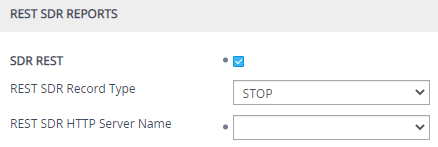Configuring SDR Reporting to REST Server
You can configure the device to send signaling-related SDRs to a REST server using AudioCodesREST API. The device sends the SDRs in JSON format.
|
●
|
For a call setup in which the egress side sends a SIP failure response code (e.g., 4xx or 5xx) that triggered the device to use an alternative route for the call, the device generates an ATTEMPT SDR. When the connected (re-routed) call ends, the device generates a STOP SDR. |
|
●
|
For a call setup in which the egress side sends a SIP 3xx response, the device generates an ATTEMPT SDR.
When the call ends, the device generates a STOP SDR.
|
|
●
|
For a forking call scenario, the device generates an ATTEMPT SDR for each forked leg that responds with failure or is terminated by the device after one of the legs accepted the call. The device also generates one STOP SDR for the forked leg that accepted the call. |
|
●
|
You can customize the fields that are included in the SDR. For more information, see Customizing SDR Fields. |
|
➢
|
To configure SDR reporting to REST server: |
|
1.
|
Configure the REST server: |
|
b.
|
Click New, and then configure an HTTP/S-based server to represent the REST server. Make sure that you configure the 'Type' parameter to General. Configure the remaining HTTP/S server parameters according to your requirements. |
|
2.
|
Open the Session Detail Record Settings page (Troubleshoot menu > Troubleshoot tab > Session Detail Record folder > Session Detail Record Settings), and then under the REST SDR REPORTS group, do the following: |

|
a.
|
Select the 'SDR REST' check box to enable the device to send SDRs to a REST server. |
|
b.
|
From the 'REST SDR Record Type' drop-down list, select the SDR type(s) that you want generated. The different SDR types are: |
|
◆
|
"START": This SDR is generated upon call connect (SIP 200 OK). |
|
◆
|
"INTERMEDIATE" SDRs: This SDR is generated during an established call. You can configure when during the call to generate the first SDR and the interval between each subsequently generated SDR. |
|
◆
|
"STOP" SDRs: This SDR is generated for successfully established and terminated calls. The SDR is generated when the call ends. |
|
◆
|
"ATTEMPT" SDRs: This SDR is generated for failed call attempts. The SDR is generated when the call attempt process ends. |
|
a.
|
If you configured the 'REST SDR Record Type' parameter to an option that includes INTERMEDIATE, then you also need to configure the intervals for INTERMEDIATE SDRs (see Configuring Intervals for Intermediate SDRs). |
|
b.
|
In the 'REST SDR HTTP Server Name' field, enter the name of the REST server that you configured in Step 1 (above). This is the server to where the device sends the SDRs. |
